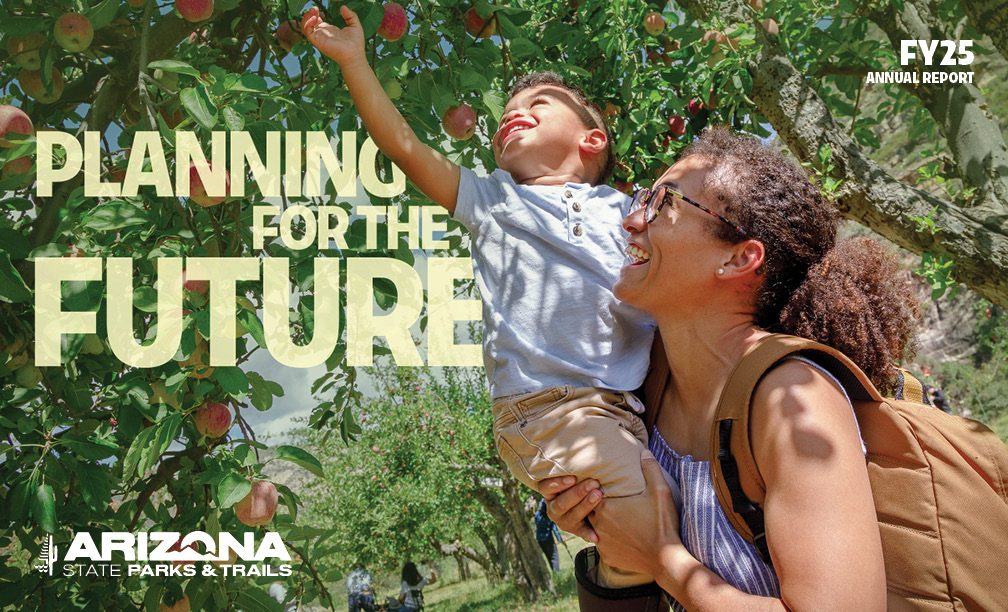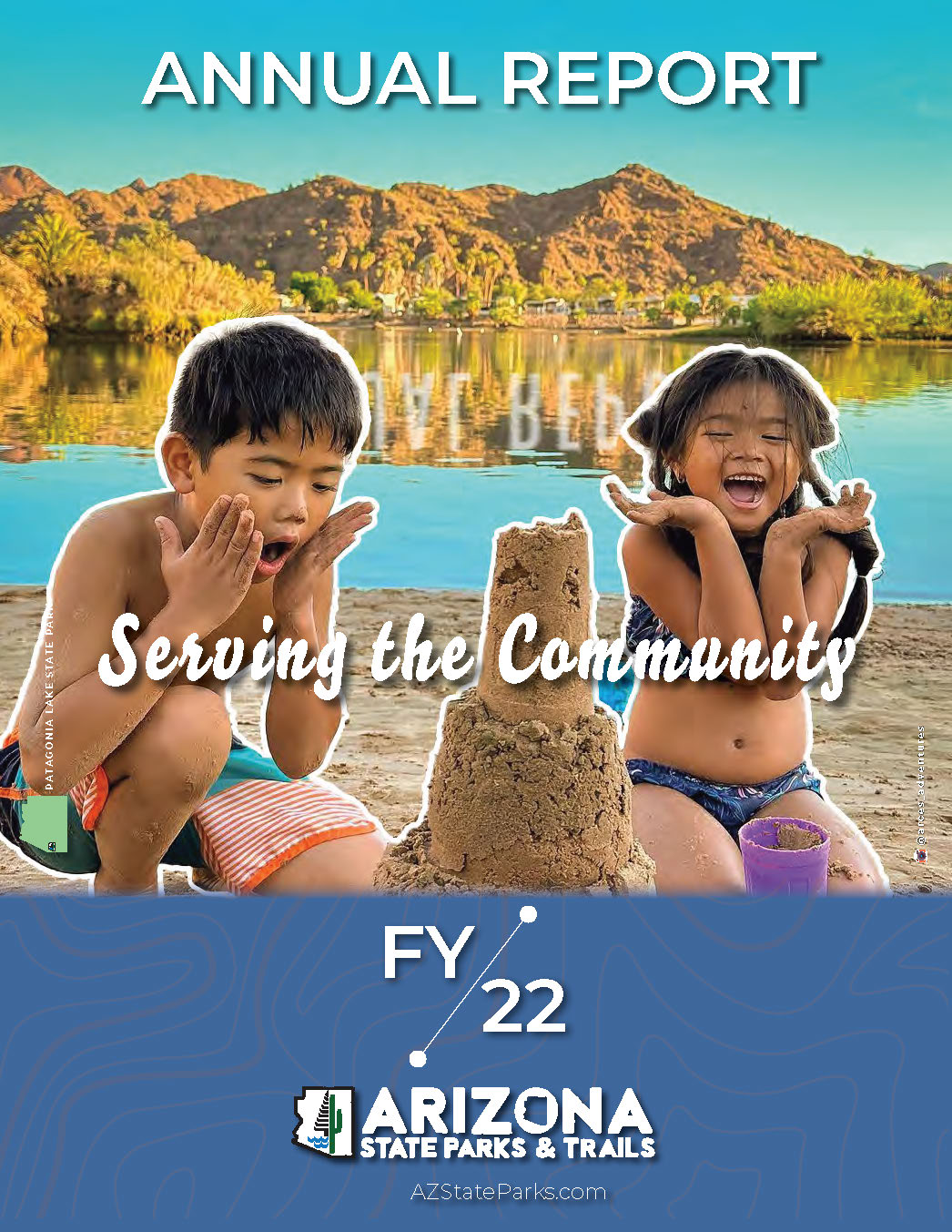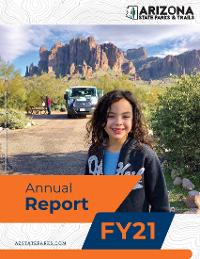
Publications
Arizona State Parks & Trails 2025-2026 Green Guide
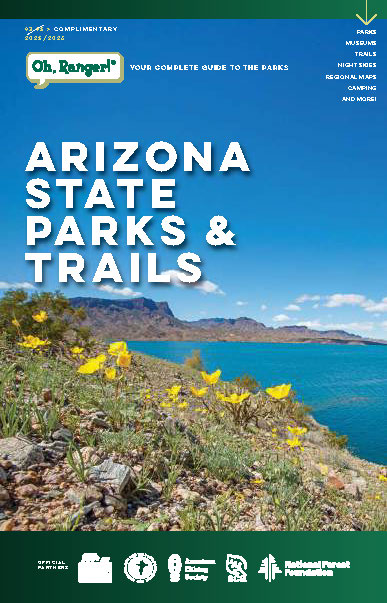 Arizona State Parks protects and preserves more than 30 state parks and natural areas. The agency also includes the State Trails Program, outdoor-related grants program, statewide outdoor recreation planning, the State Historic Preservation Office, as well as the Off-Highway Vehicle Program and more. Arizona State Parks and Trails manages some of the most beautiful destinations in the state, including Patagonia Lake State Park, Slide Rock State Park, and Lake Havasu State Park.
Arizona State Parks protects and preserves more than 30 state parks and natural areas. The agency also includes the State Trails Program, outdoor-related grants program, statewide outdoor recreation planning, the State Historic Preservation Office, as well as the Off-Highway Vehicle Program and more. Arizona State Parks and Trails manages some of the most beautiful destinations in the state, including Patagonia Lake State Park, Slide Rock State Park, and Lake Havasu State Park.
Download the latest issue of our statewide guide for what to do and where to go: Arizona State Parks & Trails Green Guide
STATEWIDE PLANNING
Statewide Comprehensive Outdoor Recreation Plan (SCORP)
2023 SCORP
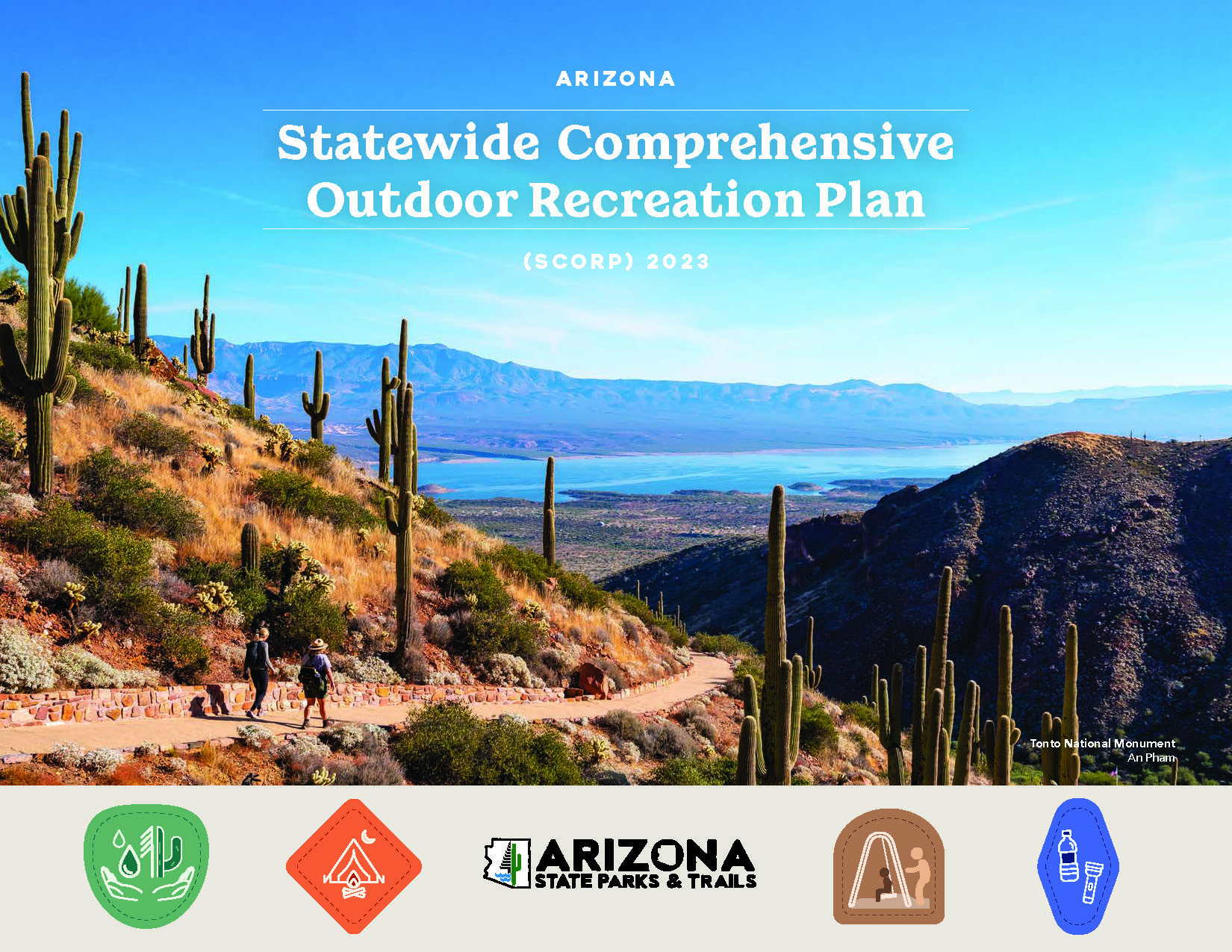 The Statewide Comprehensive Outdoor Recreation Plan (SCORP) serves as a guide for all public outdoor recreation and addresses how we, as a state, across boundaries and jurisdictions, can protect and enhance the outdoor recreation assets that help to sustain our health, our economy, and our livelihoods and support opportunities for residents and visitors alike.
The Statewide Comprehensive Outdoor Recreation Plan (SCORP) serves as a guide for all public outdoor recreation and addresses how we, as a state, across boundaries and jurisdictions, can protect and enhance the outdoor recreation assets that help to sustain our health, our economy, and our livelihoods and support opportunities for residents and visitors alike.
A collaborative and inclusive SCORP process has identified the following four priority areas for the next five years: Conservation and Environmental Stewardship, Sustainable Outdoor Recreation, Connection, Community and Economic Vitality, and Pathways to Health and Wellness. These priorities reflect the current trends, opportunities, and challenges facing Arizona’s outdoor recreation resources today. The interconnected priorities are critical components to achieving a future vision where Arizona’s outdoors continues to provide rich recreation experiences while conserving natural and cultural resources.
Arizona Trails Plan 2025
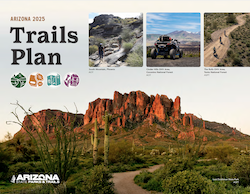 The purpose of the 2025 Arizona Trails Plan is to gather information and recommendations to guide Arizona State Parks and Trails (ASPT), other land management agencies, and stakeholders in the management and resource distribution related to motorized and non-motorized trails in the state of Arizona. It should further guide the distribution and expenditures of the Off-Highway Vehicle Recreation Fund (A.R.S § 28-1176) and the federal Recreational Trails Program (23 U.S.C. 206). The Arizona Trails Plan is updated every five years to comply with the requirements set forth in A.R.S. § 41-511.22 and A.R.S. § 41-511.04 [20]. The plan’s information can also be used to 1) promote a common understanding of statewide, regional and local issues and the potential solutions affecting all trail interests; 2) recommend funding priorities and actions to improve and maintain Arizona’s trails and routes; and 3) provide a framework for strengthening the roles of trail and OHV advocates, managers, stakeholders, and elected officials to be more effective in sustaining Arizona’s trail heritage and adding responsibly to it.
The purpose of the 2025 Arizona Trails Plan is to gather information and recommendations to guide Arizona State Parks and Trails (ASPT), other land management agencies, and stakeholders in the management and resource distribution related to motorized and non-motorized trails in the state of Arizona. It should further guide the distribution and expenditures of the Off-Highway Vehicle Recreation Fund (A.R.S § 28-1176) and the federal Recreational Trails Program (23 U.S.C. 206). The Arizona Trails Plan is updated every five years to comply with the requirements set forth in A.R.S. § 41-511.22 and A.R.S. § 41-511.04 [20]. The plan’s information can also be used to 1) promote a common understanding of statewide, regional and local issues and the potential solutions affecting all trail interests; 2) recommend funding priorities and actions to improve and maintain Arizona’s trails and routes; and 3) provide a framework for strengthening the roles of trail and OHV advocates, managers, stakeholders, and elected officials to be more effective in sustaining Arizona’s trail heritage and adding responsibly to it.
Arizona Trails Plan 2025
OHV Legislative Updates, 2019-2025
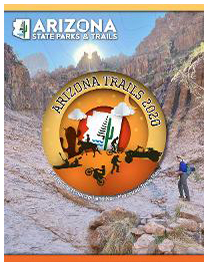
Arizona County Supplement Reports
Apache, Coconino, Gila, and Navajo
Cochise, Graham, Greenlee, and Santa Cruz Counties
2020 Economic Value of Trails in Arizona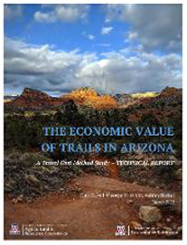
As a complement to the Arizona State Parks 2020 Trails Plan, this study estimates Arizonans’ demand for trail use and the economic value of motorized and non-motorized trail use to Arizona residents using the travel cost method. Trail use includes the use of trails managed by Arizona State Parks, the National Park Service, the U.S. Forest Service, the Bureau of Land Management, and other land management agencies for both non-motorized and motorized uses. Non-motorized uses include walking, hiking, mountain biking, and horseback riding/equestrian use, among others, and motorized uses include dirt biking, ATV use, UTV use, side-by-side use, and four-wheeling, among others. Additionally, the study includes the development of an origin-destination matrix estimating Arizonans’ travel for trail-based recreation. This can offer important insight for communities looking to develop or expand their own trail systems, or to inform tourism marketing for communities hoping to attract visitors.
These materials were developed in partnership with the University of Arizona to help advocates, trail users, managers, etc communicate the economic value of trails to other stakeholders. The dropdown menu includes county-specific reports as well as other materials augment the full report.
Six - 2030 Master Plan
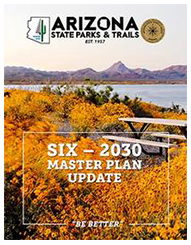 Through regular feedback we solicit from our visitors and stakeholders, key plans are created that encompass the full spectrum of recreational opportunities. This data is prioritized to provide direction for all our providers, public and private, and at all levels of government.
Through regular feedback we solicit from our visitors and stakeholders, key plans are created that encompass the full spectrum of recreational opportunities. This data is prioritized to provide direction for all our providers, public and private, and at all levels of government.
• 2014 Economic Impact Report • 2015 Trails Plan
• 2016 Boating Watercraft Survey • 2016 OHV Sticker Fund Report
• 2018 Statewide Comprehensive Outdoor Recreation Plan (SCORP)
• 2018-2022 Strategic Plan
These plans inform the Six-2030 Agency Master Plan, a long-term document that sets overall agency direction for the next twelve years, consistent with statewide plans and priorities. Progress towards agency directives identified in the master plan takes place through the implementation strategies identified in the 2018 Arizona State Parks and Trails Strategic Plan.
Download a PDF of the plan here.
Economic Impact of Off-Highway Recreation
In 2018, Arizona State Parks and Trails Off-Highway Vehicle Program partnered with Arizona State University to look at the economic impact of off-highway vehicle use in Arizona. This report highlights the findings of the study and captures information on spending habits, where people enjoy riding, and the overall impact the sport has our economy.
2017 Arizona State Parks: Off-Highway Vehicle Recreation Report
Arizona Boat & Watercraft Study Research Report
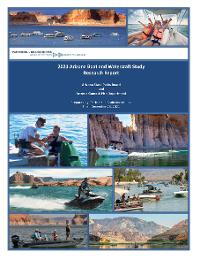 Prepared by Partners in Brainstorms, December 2021
Prepared by Partners in Brainstorms, December 2021
Prepared for: Arizona Game & Fish Department and Arizona State Parks and Trails
Overview:
The Arizona Game & Fish Department (AGFD) and the Arizona State Parks Board (ASPB) conduct a study approximately every three years on recreational watercraft usage and priorities. The primary objective of this study was to determine recreational watercraft use in each of the state’s counties by boat use days and person use days. A secondary objective was to collect selected attitudinal and behavioral data related to boat and watercraft use. In 2021, a total of 6,771 surveys were completed among Arizona registered boat owners and motorized and non-motorized watercraft users. Data from these survey respondents will help to inform the Statewide Comprehensive Outdoor Recreation Plan, future priorities and distribution of resources.
2021 Boat & Watercraft Study Research Report
Arizona Watercraft Survey Report
Prepared by: Behavior Research Center, Inc. June 2016
Prepared for: Arizona Game & Fish Department and Arizona State Parks and Trails
Overview
1. To determine the number of days of recreational watercraft use in each of the state’s counties by boat use days and personal use days.
2. To determine the water-based and non-water-based recreational activities, assess current facilities, programs and attitudes about water related-recreation issues and inform future priorities and distribution of resources.
The information on recreational watercraft usage patterns on Arizona’s lakes and rivers are necessary to plan for enforcement activities and resource allocation.
2016 Arizona Watercraft Survey
AGENCY
Arizona State Parks and Trails Strategic Plan
Arizona State Parks and Trails protects and preserves more than 30 state parks and natural areas. The Strategic Plan identifies the overall long-term strategic direction and the major initiatives of the agency. This forward-looking plan aligns actions with the agency’s vision and mission. With the focus on parks, partnerships, people, and pocketbook, the five-year strategies are:
- Optimizes park and trail system vitality (parks)
- Grow new, and leverage existing key partnerships to protect the mission (partnerships)
- Create an environment to cultivate high-performing and engaged workforce (people - workforce)
- Deliver exceptional outdoor recreation experiences to highly satisfied and engaged visitors (people - customers)
- Maximize financial sustainability and revenue growth (pocketbook)
In addition to outlining the direction, the plan serves as a management tool to track performance and outcomes.
2018-2022 Five Year Strategic Plan
Economic Impact Report
2021 Report
Economic Contributions and Impacts of Arizona's State Parks
Prepared by the University of Arizona Cooperative Extension Department of Agricultural and Resource Economics.
Executive Summary
This study presents an analysis of the importance of Arizona State Parks to the state’s economy and to the 13 county economies where state parks are located. The study measures two types of economic effects: county economic impacts and state economic contributions. Both measures are rooted in visitor spending.
In 2020, the statewide economic contribution of visitor spending in and around Arizona State Parks, including multiplier effects, was $449 million in sales. Arizona State Parks contributed an estimated $272 million to Arizona’s Gross State Product. Through visitor spending in local economies, Arizona’s state parks supported an estimated 4,200 jobs statewide.
PROGRAMS
OHV Sticker Fund Report
State Parks Board report to the Arizona Legislature regarding Off-Highway Vehicle (OHV) funds.
History of Off-Highway Vehicle Projects
FY 2018 OHV Legislative Report
ASPT Board Budget Request
FY23-24 Budget Proposal
FY24-25 Budget Proposal
FY25-26 Budget Proposal
FY26-27 Budget Proposal
